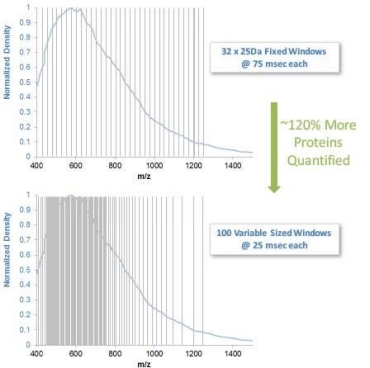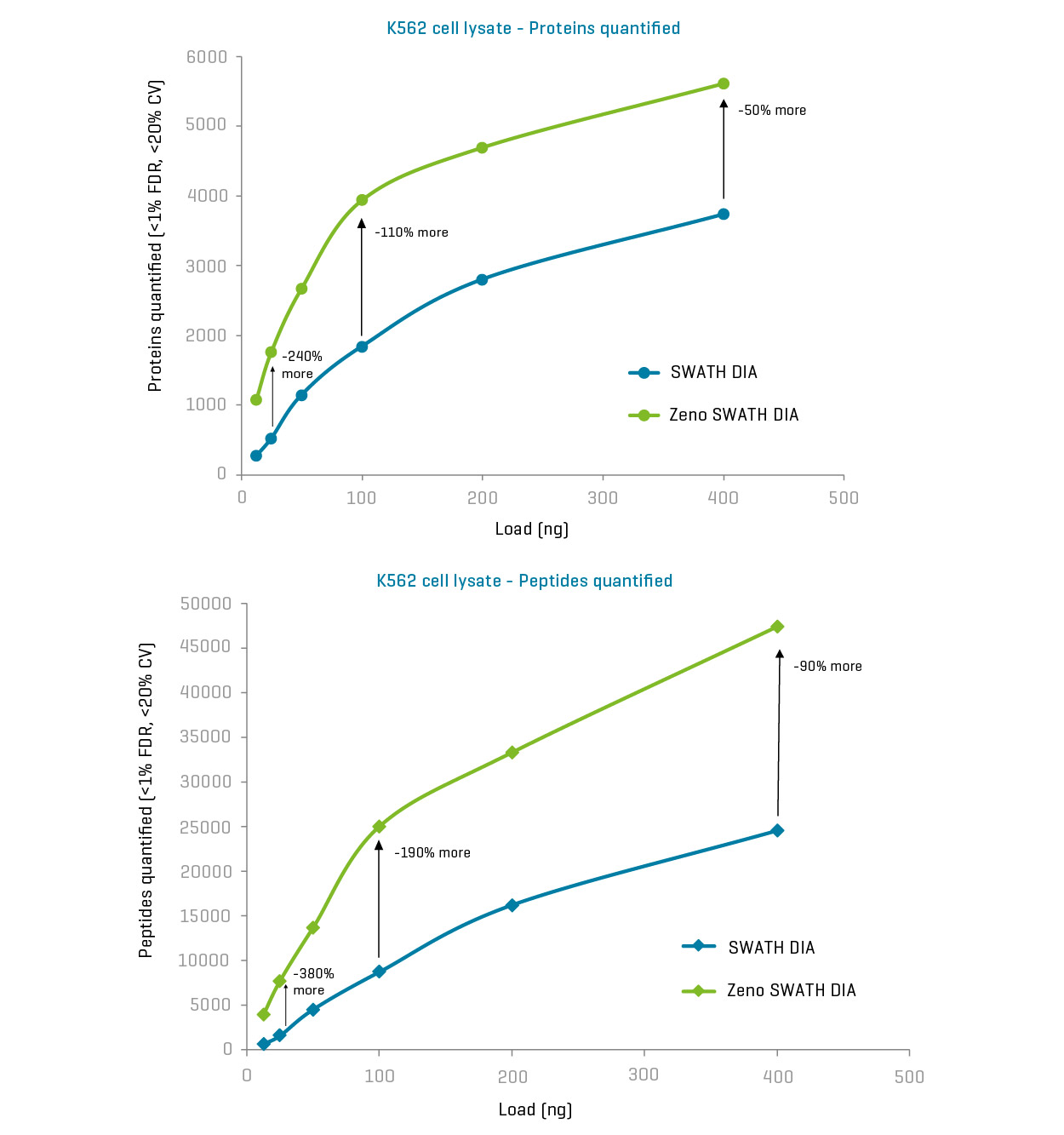Data independent acquisition (r)evolution
Since its release in 2012, SWATH DIA (data independent acquisition) has been a valuable tool for large-scale proteomic studies. SWATH DIA helps generate a permanent digital proteome map with highly reproducible retrospective analysis of cellular and tissue specimens. It combines quantitative reproducibility with the speed and sensitivity gains of modern mass spectrometers.
And now, with the support of powerful new hardware advancements, Zeno SWATH DIA reveals tens, hundreds and even thousands more identified and quantified analytes in less time and with higher precision than ever before. Reaching new depths of coverage, Zeno SWATH DIA delivers maximal information in minimal time.
SWATH DIA is a huge advantage, enabling maximum information to be derived from the data.
– Dr. Ruedi Aebersold, Institute of Molecular Systems Biology, ETH Zurich, and University of Zurich, Switzerland
Why use data independent acquisition (DIA) instead of data dependent acquisition (DDA)?
Data dependent acquisition (DDA)
DDA (also known as information dependent acquisition, or IDA) is one of the most well established accurate mass acquisition strategies. With DDA,, the mass spectrometer selects only MS1-level analytes (usually by intensity) and fragments them sequentially. This provides good quality untargeted sample analysis, with quantification performed either at the MS1 level using label-free approaches or at the MS/MS level with isotopic labels, with the latter requiring additional sample preparation time and cost. With DDA, identification at the MS/MS level can be quite precise and specific given that the mass spectrometer is fragmenting only one analyte at a time. However, since DDA mode is stochastic and does not reproducibly select the same precursor ions for every run, it is not considered a particularly quantitative approach. Also, because high-intensity precursors are typically selected for MS/MS first, under-sampling the lower abundant analytes is often an issue in complex samples.
Data independent acquisition (DIA)
With DIA, the mass spectrometer does not require the initial detection of an MS peak to proceed to MS/MS analysis. Instead, it uses a wider Q1 isolation window and steps it across the entire m/z mass detection range, collecting MS/MS spectra on every detectable analyte that passes through each Q1 window. This means the full mass range is interrogated within an LC time frame, ensuring you get the full MS and MS/MS picture of every analyte that was detectable in your sample. This provides an unparalleled level of data completeness and allows quantification of MS1 and MS/MS level analytes in complex mixtures over a wide dynamic range. And since the instrument does not rely on intensity, which can vary between injections, determining which analyte has triggered missing data is not a problem with DIA. These complete digital maps of the samples can also be retrospectively analyzed when new information or new algorithms are available since all the data is already there.
Eliminate fears of missing a relevant analyte
There are many data independent analysis techniques available for customers these days. SWATH DIA reduces the risk of missing a critical component in your sample through an unbiased, comprehensive data acquisition strategy that delivers the data completeness your experiments demand.
SWATH DIA helps you acquire MS/MS data at incredibly fast acquisition rates with high sensitivity. This is key to getting the best DIA data because it allows you to run more Q1 isolation windows for higher specificity. It also helps ensure your cycle time is fast enough to maintain good LC peak sampling for reproducible and reliable peak integration and quantification quality, even with fast chromatography. Since our introduction of SWATH DIA so many years ago, we have continued to improve upon those initial capabilities.
Learn in 10 minutes how SWATH DIA accelerates life science discovery >
Variable window acquisition
Being able to vary the Q1 isolation window size, allows you to use smaller Q1 m/z windows in the densest m/z region of your LC gradient. The result is increased specificity such that can capture deeper information on your sample, further reducing the risk of missing low abundance peaks in the most complex samples, while still maintaining broad mass range coverage to not miss anything.
Take proteomics as an example: many peptides lie in the 500-800 m/z mass range. With variable window SWATH DIA, you are able to shrink the Q1 window size in this mass range, delivering deeper coverage of peaks in this dense area of your sample, then use wider windows across the remaining mass range. This strategy maximizes the scan time of the instrument and gives you the power to dig deeper into the regions of greatest importance.
In the figure to the right, you can see how by adjusting the SWATH DIA window from a fixed 25 Da width at 80 msec each window (thus, 32 equal windows, above image), to 100 variable width windows at 25 msec each (below figure) delivers ~120% more proteins quantified in the sample.
Learn more about how variable windows improve data quality >
Zeno SWATH DIA enabled by the Zeno trap
Zeno SWATH DIA, available exclusively on the ZenoTOF 7600 system, combines the reproducibility and precision of SWATH DIA with the significant gains in MS/MS sensitivity that the Zeno trap offers to deliver maximal information from each precious sample. Together, these powerful tools lead to a more comprehensive understanding of underlying biological changes.
The Zeno trap allows access to >90% duty cycles for all fragment ions, regardless of mass charge, or LC flow rate. This provides 4- to 20-fold sensitivity gains, all without compromising other important performance specifications such as resolution, mass accuracy and speed. The Zeno SWATH DIA workflow now capitalizes on these impressive MS/MS gains to enable widespread and comprehensive analyte coverage at new depths of detection and higher throughput than ever before.
For proteomics experiments, proteins across a broader and deeper range are available for detection, as shown in the figure to the right. At protein loads of <25 ng, we saw improvements of up to 2.5–3x more proteins quantified (upper figure) and 4–5x more peptides quantified (lower figure) using Zeno SWATH DIA.
These gains allow scientists to run all kinds of experiments. You can delve into the potential of single-cell analysis, or run large-scale, high-throughput studies using robust high-flow chromatography, but with the luxury of consuming much less sample.
Additionally, the new “library-free” approach removes the initial effort involved in generating an experimental library and instead allows the creation of an in-silico library, making library creation truly “effort-free.”
Meanwhile, for metabolomics and lipidomics studies, Zeno SWATH DIA delivers metabolites and lipids at deeper levels. In drug metabolism studies, new metabolites are revealed that may be potentially toxic or can aid in better understanding pharmacokinetics and drug fate.
The reach of Zeno SWATH DIA is far and wide and continues to grow across different application areas. SCIEX is proud to innovate on an already successful acquisition scheme and is excited to see what our customers do with their Zeno SWATH DIA data.
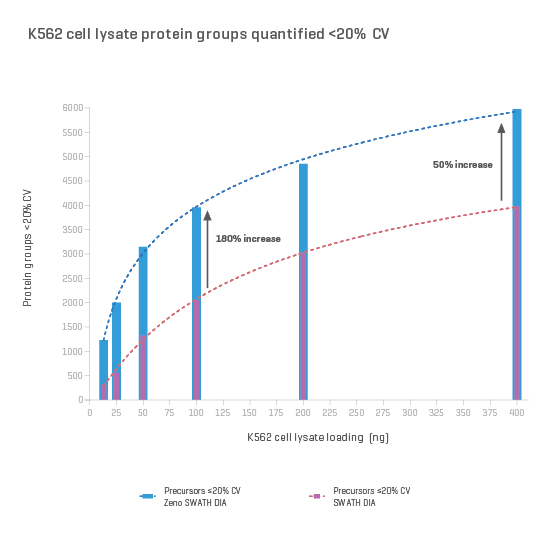
Sensitivity: more proteins identified, more proteins quantified
Experience the 5–6x increase in peptide MS/MS sensitivity that the Zeno trap provides, all while maintaining the same critical performance specifications you have come to rely on.
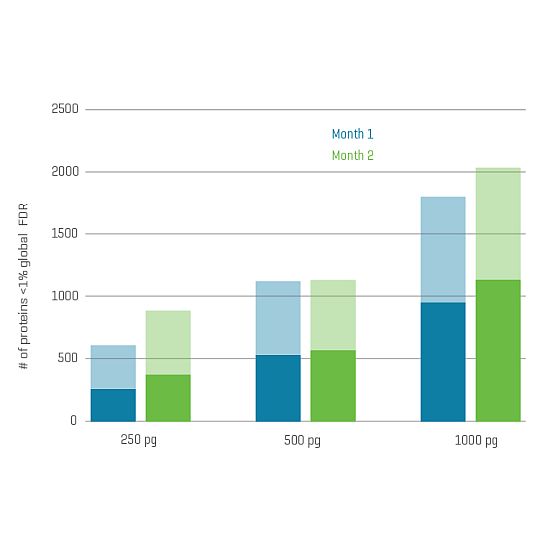
Reproducibility: achieve excellent inter-day precision of quantification
As sample loading decreases, run-to-run variability in protein identification and quantification can become more extreme. Because of the data-independent nature of Zeno SWATH DIA, you can stop worrying about poor reproducibility when using low sample loadings.
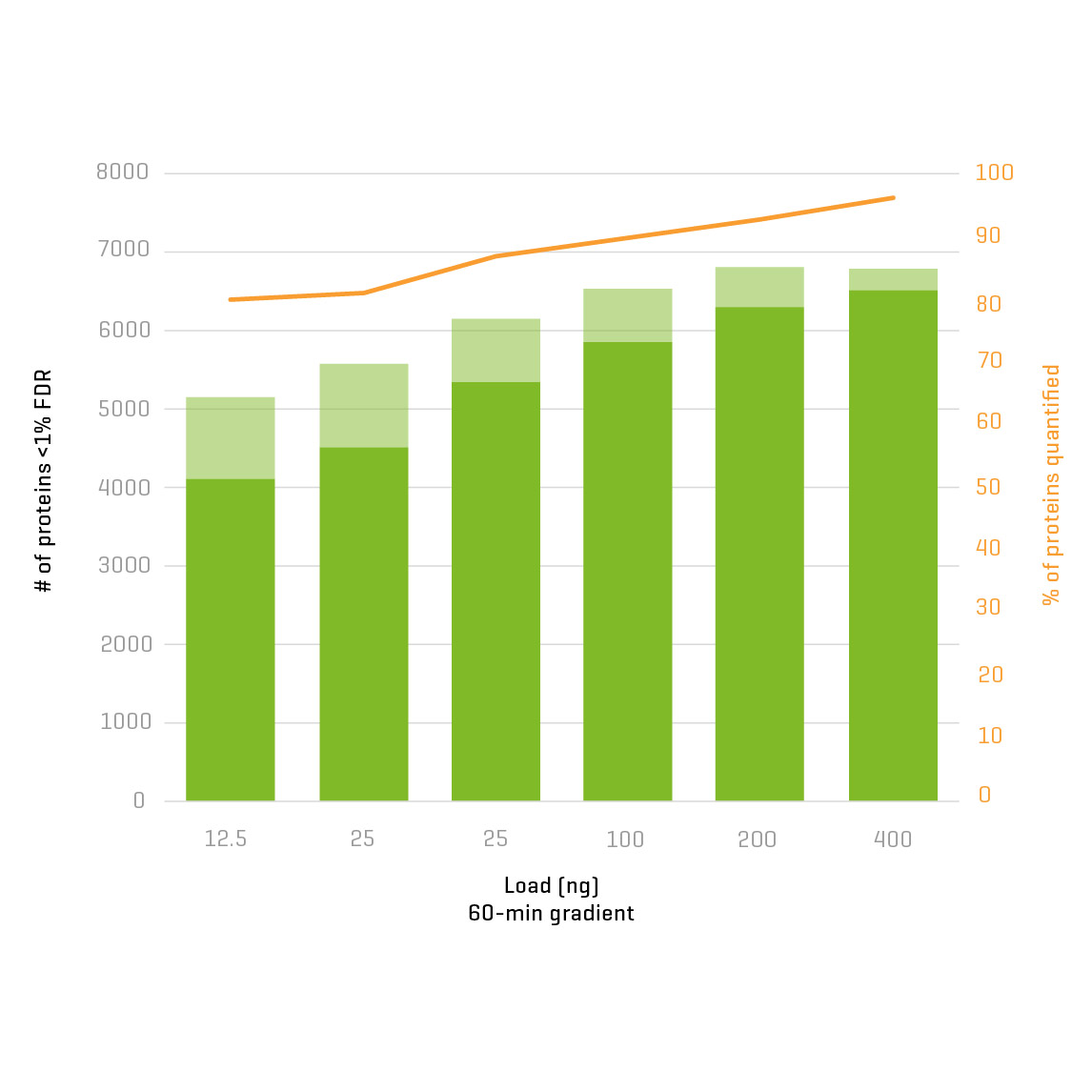
Higher productivity: proteome coverage and quantitative reproducibility in a single run
Fully leverage the sensitivity gains provided by the Zeno trap to get even more proteins quantified from your nanoflow chromatography on low amounts of proteomic sample. With Zeno SWATH DIA, you get 4,000–6,000 quantified proteins in a single 1-hour run.
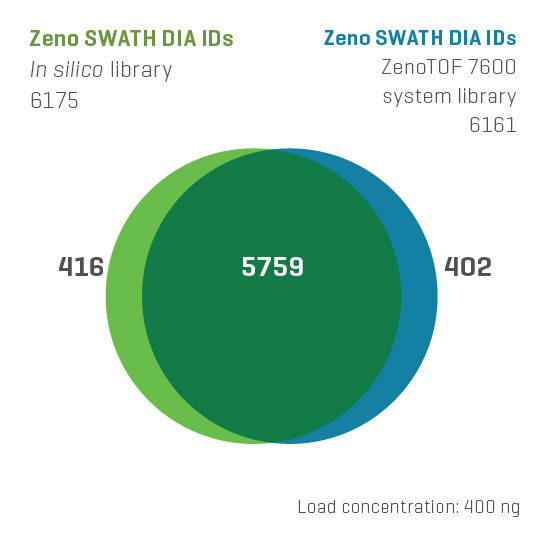
Go library-free: eliminate the need to build spectral libraries
By using an in silico-generated library, you can run faster with a more streamlined workflow for protein identification and quantification while retaining a depth of coverage that is similar to experimental libraries.
Going library-free for protein identification using Zeno SWATH DIA and in silico-generated spectral libraries
This Zeno SWATH DIA workflow, which uses DIA-NN software and an in silico-generated library for processing data, outperformed the traditional shotgun proteomics approach that uses Zeno DDA for the identification of large numbers of proteins from complex samples. The Zeno SWATH DIA workflow also demonstrated high agreement with two commonly used experimentally generated libraries.
Zeno MS/MS with microflow chromatography powers the Zeno SWATH DIA workflow to quantify more proteins
As quantitative proteomics evolves, larger biological cohorts are being studied, often using precious samples. This creates the need to acquire data faster and using smaller amounts. Using Zeno SWATH DIA with Zeno MS/MS and microflow LC has the potential to enhance core quantitative proteomics workflows significantly.
High-throughput quantitative proteomics using Zeno SWATH DIA and the Evosep One system
In translational research, proteins and peptides are important for understanding biological function. The Zeno trap provides a 5–6x more peptide MS/MS sensitivity, resulting in a powerful DIA workflow that is compatible with fast quantitative proteomics.
Protein quantification at subnanogram loads using Zeno SWATH DIA and nanoflow chromatography
Zeno SWATH DIA in the ZenoTOF 7600 system leverages Zeno trap activation for a 5–6x increase in peptide MS/MS sensitivity. This high sensitivity opens the door to performing label-free proteomics on very low amounts of proteomic samples.
Nanoflow Zeno SWATH DIA for high-sensitivity protein identification and quantification
Nanoflow chromatography is used in workflows to obtain the highest sensitivity. High-quality chromatographic separations are important, as good peak shape and peak resolution can reduce ion suppression and allow the MS system to sample as many unique peptides as possible.
Large-scale protein identification using microflow chromatography
Using microflow chromatography with fast MS/MS acquisition and then searching the data in the cloud can enable large-scale protein identification in a short amount of time. Here, using the ZenoTOF 7600 system and two fractionated human cell lines, a very deep DIA library was generated in <48 hours.
Integrating DIA-NN software analysis of SWATH DIA into a cloud processing pipeline
The OneOmics suite is a unified platform that provides researchers with tools for multi-omics data management, compound identification and quantification, statistical analysis and pathway analysis to streamline biomarker discovery studies. This cloud-powered solution also enables rapid and secure sharing of results with collaborators. Here, a complete processing workflow for proteomics analysis is presented using Zeno DDA and Zeno SWATH DIA data acquired on the ZenoTOF 7600 system.
Flexibility, speed, and throughput for high proteome coverage
This work demonstrates the use of Zeno SWATH DIA on the ZenoTOF 7600 system coupled with the Evosep One system to achieve quantitative proteomics on both HeLa cell and nondepleted human plasma digests. The sensitivity of the ZenoTOF 7600 system is demonstrated at different throughput levels. At 30 samples-per-day (SPD), >8,000 protein groups were identified from 200 ng of HeLa digest, while at 500 SPD, >270 protein groups could be identified from 50 ng of non-depleted human plasma.
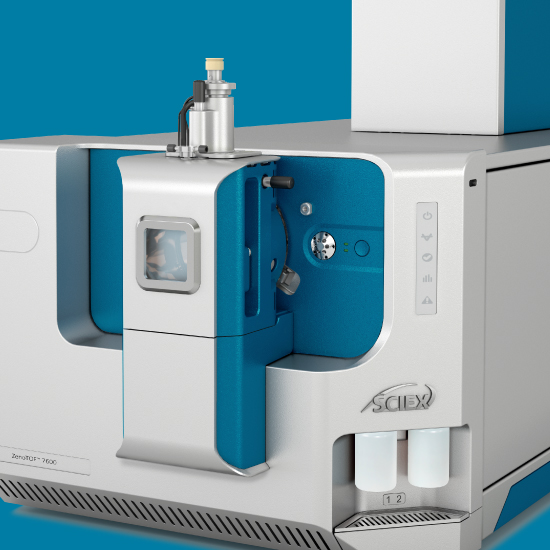
ZenoTOF 7600 system
The ZenoTOF 7600 system is a novel accurate mass spectrometry solution that combines rich MS/MS data with impressive sensitivity, powerful new fragmentation technology and a step-change in data independent acquisition for characterization and quantification.
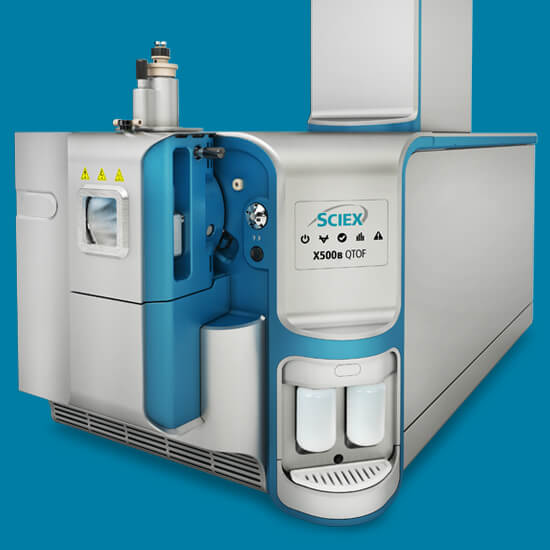
X500R QTOF system
The X500R QTOF system reduces the complexity of accurate mass spectrometry while maintaining the quantitative capabilities you need for various targeted and untargeted analyses.
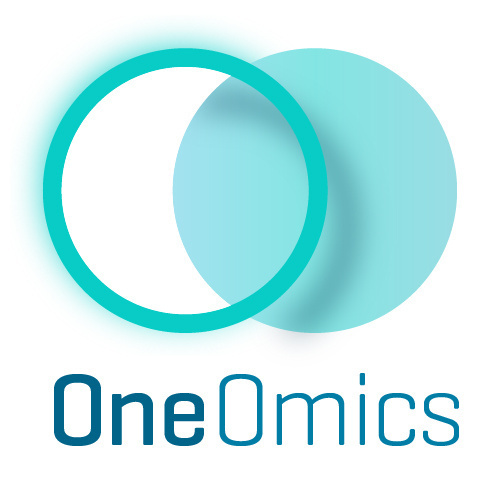
OneOmics suite
Use the power and scalability of cloud-based software to extract and visualize mass spectrometry data from multi-omics projects, and share those biological insights widely and easily with collaborators.

Markus Ralser, The Francis Crick Institute
Ultra-fast proteomics—How it opens new doors for gene function prediction, drug screens and clinical proteomics using AI

Iulia Macavei, Université Claude Bernard Lyon 1
Fast and accurate identification and antibiotic resistance profiling of microorganisms in blood cultures by SWATH DIA proteomics

